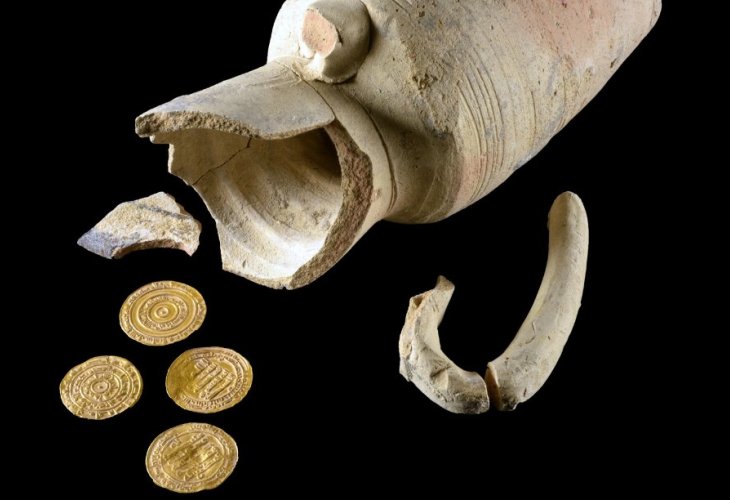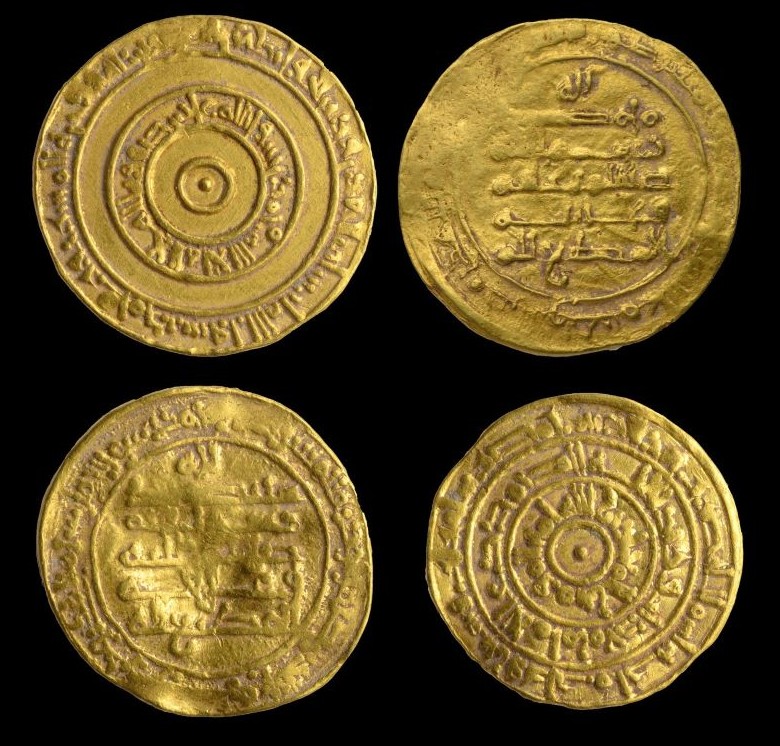A Thousand-Year-Old Gold Coins Unearthed in Jerusalem
In a groundbreaking archaeological dig for a new elevator project at the Western Wall, a small clay jug revealed four pristine gold coins, dubbed an "ancient savings jar."
 The jug and gold coins (Photo by: Dafna Gazit, Israel Antiquities Authority)
The jug and gold coins (Photo by: Dafna Gazit, Israel Antiquities Authority)A small clay jug containing four pure gold coins dating back over 1,000 years to the early Islamic period was discovered during an archaeological excavation by the Israel Antiquities Authority. The dig is part of a project by the Company for the Development of the Jewish Quarter to construct an elevator that will improve access to the Western Wall for visitors.
The jug and its precious contents were unearthed by Yael Kapil, an officer from the Israel Antiquities Authority, during preliminary work done at the site during the holidays. A month later, when the excavation director, archaeologist David Gelman, reviewed the findings, he emptied and washed the jug.
"To my great surprise," Gelman recounts, "along with the sand, four gleaming gold coins washed into my hand. It's the first time I've discovered gold as an archaeologist, and the thrill is immense. It appears the jug was used as an ancient savings jar."
 The jug and the gold coins found within (Photo by: Dafna Gazit, Israel Antiquities Authority)
The jug and the gold coins found within (Photo by: Dafna Gazit, Israel Antiquities Authority)According to Dr. Robert Cole, a coin expert at the Israel Antiquities Authority, "The coins are remarkably well-preserved, and we could read them immediately upon removing them from the jug, even without cleaning. They date from a relatively short period, from the late 940s to the 970s CE. This was a time of significant political change, as control of Israel transitioned from the Sunni Abbasid Caliphate based in Baghdad to their Shiite rivals – the Fatimid dynasty from North Africa, who at the time had conquered Egypt, Syria, and Israel."
"These historical events are vividly reflected in the distribution of the coins found in the jug: two gold dinars were minted in Ramla under the rule of Caliph Al-Muti (946-974 CE) and his governor in the region, Abu al-Qasim ibn al-Ikhari (946-961 CE). The other two coins were minted in Cairo by the Fatimid rulers Al-Mu'izz (953-975 CE) and his successor Al-Aziz (975-996 CE)."
Dr. Cole notes that "This is the first gold treasure from the Fatimid period discovered in Jerusalem's Old City in fifty years. The extensive excavations led by Prof. Benjamin Mazar in the Old City after the Six-Day War uncovered five hoards of coins and jewelry from that period, found south of the Temple Mount."
"Four dinars would have been a significant sum for most people living in those days under basic subsistence conditions," adds Dr. Cole. "This amount equaled a junior clerk's monthly salary or four months of wages for a simple laborer. Compared to the average person then, a small group of wealthy officials and merchants earned substantial fortunes. A senior treasury official might earn around 7,000 gold dinars a month, and some had rural estate incomes reaching hundreds of thousands of gold dinars annually."
Herzl Ben Ari, CEO of the Company for the Development of the Jewish Quarter, who happened to visit the site during the coin discovery, says, "Although we are accustomed to archaeological findings from time to time, each discovery is an exciting event, revealing the unique and tumultuous history of Jerusalem. After the elevator project is completed, we intend to open wide sections of the archaeological findings to the public."
 The gold coins (Photo by: Dafna Gazit, Israel Antiquities Authority)
The gold coins (Photo by: Dafna Gazit, Israel Antiquities Authority)
